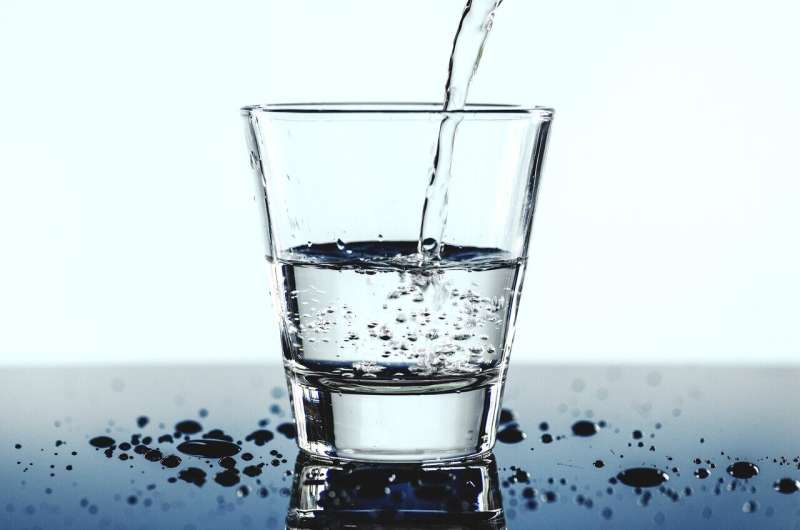This article has been reviewed according to Science X's editorial process and policies. Editors have highlighted the following attributes while ensuring the content's credibility:
fact-checked
proofread
Protecting water resources from long term pollution

Increasing levels of toxic, synthetic chemicals are being reported in drinking water and drinking water reservoirs in Europe and around the world. One of the most notorious groups of these synthetic chemicals are PFAS, which have been also referred to as "forever chemicals," as they accumulate in natural environments and do not naturally degrade.
PFAS are only the tip of the iceberg. There are several other groups of synthetic, persistent substances that are increasing contaminating water resources. The larger group—or iceberg—is referred to as "persistent, mobile and toxic" substances and "very persistent, very mobile" substances, abbreviated as PMT/vPvM substances.
Many of the PMT/vPvM substances are challenging for water authorities, as many of them cannot be monitored due to a lack of methods and cannot be removed from the by activated carbon filters or by ozonation. The German Environment Agency (UBA) has sought to address this hazard from PMT/vPvM substances for several years.
Many recent policy actions have been happening recently in Europe as a response to this increasing contamination. In Europe, plans are underway to implement a broad restriction for all PFAS. In April, PMT/vPvM substances were officially labeled as new type of hazardous substance in Europe, through the introduction of PMT/vPM hazard categories in the regulation on Chemicals, Labeling and Packaging.
To provide further guidance on avoiding and managing PFAS and PMT/vPvM substances, UBA has commissioned the Norwegian Geotechnical Institute (NGI) to prepare four new reports, which have all been released simultaneously. Each report focuses on different aspects.
The first report is an update of a guidance document to assess if a chemical substance would meet the PMT/vPvM criteria. The second report presents a literature review of synthetic substances that have been detected in water, including in drinking water, waste water, groundwater, and discusses how many of these are PMT/vPvM substances. The third report presents a list of 343 PMT/vPvM substances for action. Finally, the fourth report presents a strategy for prioritizing which PMT/vPvM substances deserve the most attention, and also includes surveys and an environmental monitoring campaign regarding these substances.
UBA President Dirk Messner considers that the chemical industry has a duty to minimize emissions of these PMT/vPvM substances. "The sustainable protection of our drinking water resources and human health must have priority in this context. Because once drinking water resources are polluted with persistent chemicals, this will be almost impossible to remediate, or will require immense effort and expense."
Furthermore, a extensive literature search shows that already today more than 600 chemicals have been detected in our water resources. Around half of the chemicals detected fall under the European chemicals regulation REACH. Many of these are PMT/vPvM substances.
Dr. Christiane Rohleder, State Secretary at the Federal Ministry for the Environment, Nature Conservation and Nuclear Safety, said, "These results are extremely important and show that this class of substances is a relevant issue for our water resources. I therefore call on industry to take the necessary measures on its own initiative and as a precaution to avoid further entry of these substances into the environment as far as possible."
The lead author of all four reports, Hans Peter Arp, an expert advisor at NGI, says "There are many questions and concerns about how to best tackle the threat of PFAS and PMT/vPvM substances; we hope that these four reports should help society tackling this issue. We particularly hope that these reports will help pave the way for officially including PMT/vPvM hazard criteria in the upcoming revision to Europe's chemical regulation, REACH."
Arp also sees these reports as having international relevance beyond Europe. "Europe is starting an initiative to introduce the PMT/vPvM hazard criteria to be recognized by the United Nations, these reports could also facilitate this recognition. If successful, this would help develop a global strategy for reducing this intergenerational, chemical threat to water security and quality."
More information: REACH: Guidance and Methods for the Identification and Assessment of PMT/vPvM Substances. www.umweltbundesamt.de/publika … r-the-identification
PMT/vPvM assessment of REACH registered Substances Detected in Wastewater Treatment Plant Effluent, Freshwater Resources and Drinking Water. www.umweltbundesamt.de/publika … egistered-substances
Prioritised PMT/vPvM substances in the REACH registration database. www.umweltbundesamt.de/publika … stances-in-the-reach
A prioritization framework for PMT/vPvM Substances under REACH for registrants, regulators, researchers and the water sector. www.umweltbundesamt.de/publika … r-pmtvpvm-substances
Provided by NGI Norwegian Geotechnical Institute




















